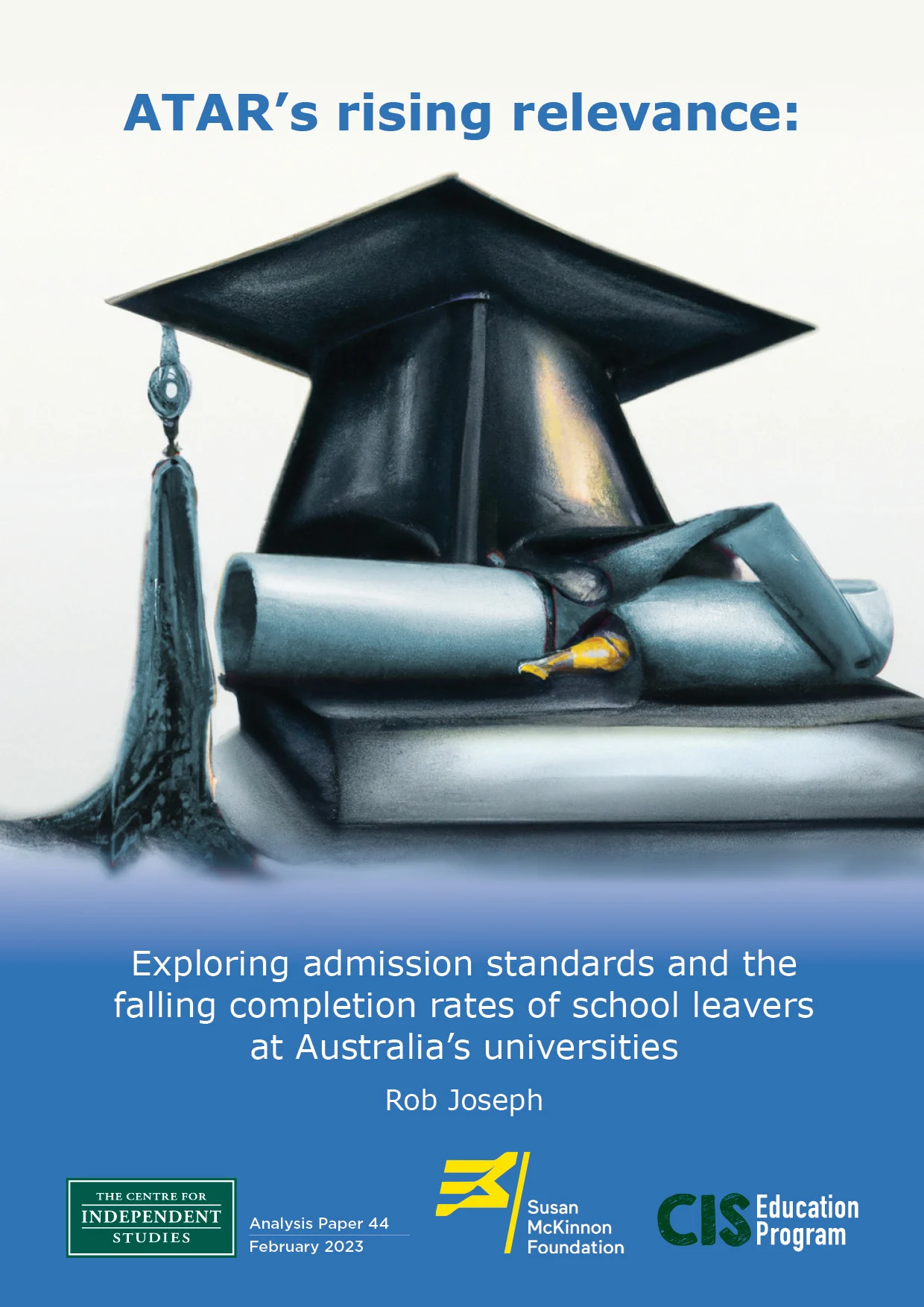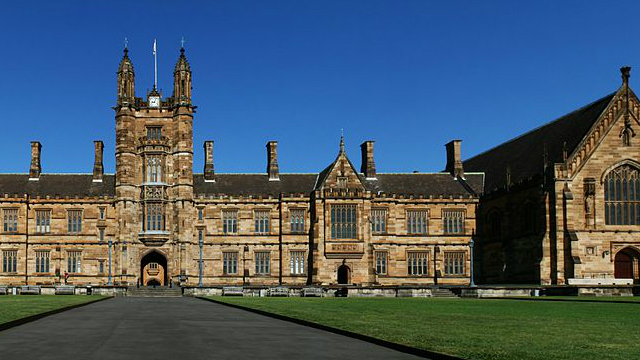
Join us on Wednesday, 27 March, as we welcome Sarah Powell to CIS to discuss possible sources for declining proficiency of Australian students in mathematics – including what evidence-based teaching looks like in maths and debunking myths and misconceptions about what works best. Sarah will be joined by Toni Hatten-Roberts in this discussion, which will be hosted by Glenn Fahey, the CIS Education Program Director.
Executive Summary – ATAR’s rising relevance: admission standards and completion rates
For more than a decade there has been an ongoing debate around ATAR’s suitability and future, and in particular, its role in university admissions criteria. This debate is especially relevant today when more school leavers are failing to finish their university degree on-time (completion) or are dropping out of university entirely (attrition).
This paper looks at past research and recent data on ATAR with respect to university admissions, completions, and attrition, with a particular focus on the growing category of students admitted on a non-ATAR basis.
ATAR remains the dominant pathway to university for school leavers. Recent estimates show almost three-in-four school leavers use ATAR to gain university entry; 60% use solely ATAR, and 14% use ATAR in conjunction with other criteria. The share admitted on a non-ATAR basis has grown from 15% in 2016 to at least 25% today.
ATAR is significantly associated with completions and attrition; with each ascending ATAR band, completions rise and attrition fall. Low ATAR students (with scores of 0-60) drop out at rates about three times that of high ATAR students (80-100).
Non-ATAR based admissions are almost twice as likely as ATAR-based admissions to drop out of university in their first year. Additionally, completion rates are falling faster for non-ATAR based admissions than any other ATAR band, declining by 4.9 percentage points over the decade, over twice the drop for all school leavers.
Despite rhetoric around non-ATAR pathways being ‘fairer’ or more ‘equitable’, in practice universities appear to be using this method as an opaque way to admit low-ATAR students, without commensurate increases in support needed to complete their degrees.
The Australian Government could help address these problems in admissions, completions, and attrition for school leavers by reforming transparency and financial incentives for universities.
On transparency, the government should require universities to record any ATARs of school leavers admitted on a non-ATAR basis. Additionally, admission reporting standards for universities should be shifted from a voluntary to a mandatory basis, given the longstanding problem of many universities not complying with reporting guidelines.
On financial incentives, when school leavers drop out of higher education, universities should be required to pay a share of the government’s contribution to those students’ tuition costs. This would correct the distorted financial incentives for universities – to enrol as many students as possible and teach them as cheaply as possible – and encourage them to invest in making their admissions process more rigorous and to improve support for students at risk of attrition.
On early intervention measures, universities should be required to have in place procedures that identify students at risk of attrition, then provide either remedial support well in advance or else remind them of the option to drop out earlier before incurring financial debt.
Even small improvements in completion rates could benefit substantial numbers of young people. Using the most recent school leaver estimates from Course Seeker (2018 to 2022), if completion rates for students admitted on a non-ATAR basis could be increased to that of those admitted on an ATAR basis, an extra 3,800 students would finish their degrees each year.
Introduction
Public discourse on ATAR
ATAR definition: The Australian Tertiary Admission Rank (ATAR) is a number between 0.00 and 99.95 that indicates a student’s position relative to all the students in their age group within their state or territory. It is calculated from the student’s academic performance in their senior secondary years, Years 11 and 12. It is a rank, not a mark. The average ATAR is usually around 70. It has typically been the main criteria for school-leaver entry into undergraduate courses at Australian universities.
It is a curious feature of educational discourse in Australia that at a time university admission standards have never appeared less rigorous, the most rigorous measure of these standards has never been disputed so consistently.
ATAR has variously been described by commentators as “increasingly redundant”, “outdated”, and facing a “slow death”. Its opponents argue ATAR is too narrow a measure of achievement, creates too much exams stress for students, and does not consider ‘critical thinking’ skills, wider life experiences, or socio-economic disadvantage.
More substantially, multiple reviews have called for ATAR’s usage to be scaled back or abolished entirely. The Shergold review of senior secondary pathways called for a reduced emphasis on ATAR. The Masters review of the NSW curriculum called for ATAR to be scrapped entirely, although the NSW Government rejected the recommendation.
Learner Profiles, a sort of ‘digital education passport’ or ‘extracurricular CV’, have been proposed as more ‘holistic’ alternatives to ATAR. Pilot projects are in development in multiple jurisdictions, such as South Australia and New South Wales. However, these have been criticised for their potential to advantage students from higher socio-economic backgrounds who have more opportunities for extracurricular activities and help with take-home assignments.
While there is a genuine debate to be had on the value of ATAR against alternative measures, there is less of a debate and more of an empirical answer when it comes to the current relevance of ATAR.
Regularly, statements are made that ATARs are being used less in university admissions, and are a poor predictor of university performance, yet there is little recent data or research accompanying such assertions.
This paper reviews past research and the latest data from universities and the Commonwealth Department of Education to answer these underlying questions, namely:
- How often is ATAR used in university admissions for school leavers?
- How is ATAR related to university completions and attrition for school leavers?
Background on Australian universities
There are more than 1.1 million Australians enrolled in university or other higher education institutions, with a further 400,000 international enrolments at universities.
Australia has 43 universities; 38 public, and five private. Universities Australia is considered the peak body for the sector, representing 39 universities. Separately, there are several ‘groups’ of universities, organised to collaborate on common interests, with the most prominent being the Group of Eight (Go8), comprising the most research-intensive universities.
FUNDING
The government provides significant funding for domestic (Australian or New Zealand) students in undergraduate study at universities. Most of these students occupy Commonwealth Supported Places (CSPs), where the government subsidises a share of the funding as part of the Commonwealth Grant Scheme (CGS). The remaining share comes from the student contribution, which Australian students can fund through a government-funded scheme (HECS-HELP for CSPs), liability to be progressively paid down once the student earns income above a certain threshold. Universities can offer additional CSPs, but without attracting the government subsidy, although domestic students in these places are still eligible for government funding. International students pay ‘full fees’ without being eligible for government subsidies or funding.
In 2020, university revenue from CSPs was made up of 58% from government contributions (CGS) and 42% from student contributions.
More broadly, Australia spends 1.92% of GDP on tertiary education, the sixth highest share in the OECD. Around one third of this is public expenditure, and two thirds private, with the latter including the low-interest government student schemes such as HECS-HELP and FEE-HELP.
In recent times, some notable amendments have been made to the funding arrangements.
From 2021, the Job-ready Graduate package came into effect, which changed the cost for different disciplines (some degrees attracted more government assistance, and some less).
From 2022, students who have failed more than 50% of their courses after a year of study, will lose eligibility for government financial assistance for their current course.
From 2024, a performance-based funding scheme for universities is scheduled to come into effect “…to ensure universities focus sufficient attention on the quality of their teaching and student support”. The performance measures are graduate employment outcomes (weighted 40%), student experience (20%), student success (20%), and equity group participation (20%) by Indigenous, low socioeconomic status and regional/remote students. The ‘student success’, or attrition target, is adjusted for each institution based on five factors of its student profile: study type (full-time or part-time), study mode (internal or external), basis of admission (secondary education, VET, etc.), field of education, and age.
The scheme will initially apply to 1.36% of the government’s contribution to student fees for bachelor degrees, and then be incrementally increased over the following years to 7.5%. A ‘poor’ performance will still attract 60% of the performance-based funding, although consistent ‘poor’ performance “over some time” could see this share drop to 40%.
Similar performance funding models for universities are used overseas, in places such as Germany, Finland, and more than 30 US states. The performance share of public funding tends to range anywhere from 15% to 85%.
ADMISSION PATHWAYS
Students at Australian universities are enrolled in a mix of undergraduate (usually a Bachelor degree) and postgraduate courses. Of those in undergraduate study, at least 43% come from recent secondary education (usually school). School leavers apply for university in one of two ways: a direct application (including early offer schemes) to an individual university, or via a tertiary admissions centre (TAC). Each state runs a TAC, which processes applications for a range of universities, and calculates ATAR.
The government’s Course Seeker website defines three categories of university admission pathways for school leavers (specifically, applicants whose admission is based on secondary education completed in the current year or previous two years):
Admitted solely on the basis of ATAR (regardless of whether this includes the consideration of adjustment factors such as equity or subject bonus points);
Admitted where both ATAR and additional criteria were considered (e.g., portfolio, audition, extra test, early offer conditional on minimum ATAR); or
Admitted on the basis of other criteria only and ATAR was not a factor (e.g., special consideration, audition alone, schools’ recommendation scheme with no minimum ATAR requirement).
Many universities offer adjustment factors (formerly known as bonus points) as additional points used in combination with ATAR, that can increase an applicant’s selection rank. Common types of adjustment factors are Elite Athlete and Performer, Equity (applicant characteristics associated with disadvantage), Location (proximity to the institution, for example, rural applicants), or Subject (particularly relevant secondary subjects the applicant studied).
For those applicants who do not meet the standard entry criteria for their desired course, there are usually alternative pathways available. These can include completing a non-degree course first, such as foundation studies, a preparatory course, or a sub-bachelor course (certificate, diploma, etc.), which may then form the basis of entry to a particular degree course.
Many universities also offer a mature-aged entry scheme, or special consideration for students who have experienced disruption to their study. Finally, it is common for students to complete a year of study in a lower-preference course, and then apply to switch to their first-preference course, using their first-year grades as a basis of admission.
THE ‘DEMAND-DRIVEN SYSTEM’
One of the most significant university trends in recent times was the demand driven system, in place between 2010 and 2017, which uncapped government-funded student places at university. It was intended to increase the share of Australians going to university, particularly those from disadvantaged backgrounds or under-represented groups. An attendant effect of this was more admissions of low-ATAR students.
The policy succeeded in increasing participation and equity of access to university, and even on the policy’s cessation, enrolments remained at much higher levels than before its inception. Such goals are also the focus of federal Education Minister Jason Clare’s recent announcement of 20,000 new university places to “…give more students from under-represented backgrounds the chance to go to university.”
However, these efforts have had a more ‘mixed report card’ when it came to retention and completion.
As the Productivity Commission noted in 2019:
“Overall, the demand-driven system succeeded in increasing the number of students and made progress in improving equity of access. However, many are entering university ill-prepared and struggling academically.”
Early Offers
Direct applications include early offer schemes, where school students receive offers before finishing their study. Such offers can include criteria both academic (for example, Year 11 and pre-exam Year 12 results) and non-academic (for example, extracurricular activities, or allowances for educational disadvantage). These offers can be either unconditional, or conditional on the student’s performance in exams. Conditional offers are considered ATAR-based admissions.
Universities are under no obligation to release early offer figures, and as such, no complete counts are publicly available. Nevertheless, it is known that the number of early offers has been increasing. In NSW and ACT, there were an estimated 39,000 early offers made for study in 2023. While early offers have been welcomed for reducing stress for Year 12 students, they have been criticised for reducing student motivation to study for final exams. Following such concerns, in NSW the early offer program is being reviewed, and new guidelines being developed. As such, it is expected the share of early offers will stabilise or decline in the near future.
Completions and attrition for school leavers at university
Possibly the most important and under-reported issue in universities today is the record share of students never finishing their study. With each year, more students are failing to finish their degree on-time (completion) or dropping out of university entirely (attrition). This trend is seen across most types of students, including school leavers.
For school leavers studying a bachelor degree, three in 10 do not complete their degree within six years, and almost one in five drop out before finishing. Among this year’s cohort of school leavers, it is expected more than 34,000 will start a degree they will not finish on-time, including more than 20,000 who will drop out altogether.
Students not completing their study is not only an inefficient use of taxpayers’ resources, with respect to the government contribution to student fees, but far more importantly, a waste of money and time for those students themselves — who incur the cost of debt for classes taken but without the benefit of a qualification.
Of course, some attrition is unavoidable, and indeed a natural trade-off of greater access to university study. Some students may only realise they have made the wrong choice after already beginning study, and others may drop out for unforeseeable factors beyond anyone’s control. Obviously if a student discovers university is the wrong pathway for them, then the earlier they exit, the better.
Yet long-term worsening trends in both completions and attrition imply a point beyond the optimal balance in this trade-off, with a high cost for those involved.
While some responsibility lies with students and those who advise them (schools and family, for example), some blame must go to the universities themselves, for either admitting school leavers with a poor chance of success, or not providing them the support necessary to succeed. That is, universities have a duty of responsible admission standards and providing sufficient student support.
As noted in the legislated Higher Education Standards Framework governing universities:
“The higher education provider is able to demonstrate appropriate progression and completion rates…”
“The higher education provider has effective mechanisms to identify and support students who are at risk of not progressing academically.”
“Admission criteria for the course of study … ensure that students have adequate prior knowledge and skills to undertake the course of study successfully.”
Thus, admission criteria are central to the problem of attrition – and the most widely-used admission criteria is the ATAR.
Past Research
A selection of relevant past research is briefly noted below. No presumption is made that these authors would necessarily share the conclusions of this report.
The broad benefits of ATAR over alternatives have been concisely articulated in opinion pieces by Ittima Cherastidtham, Andrew Norton, Greg Ashman, Blaise Joseph, and others.
On ATAR’s use in university admissions, in 2018 Norton navigated the confusion to point out “…ATAR is still used in the vast majority of school leaver university admissions…”, with 75% of 2016’s school leavers being admitted solely on ATAR, and a further 10% admitted on ATAR in conjunction with other criteria.
On ATAR’s usefulness in predicting university performance, the University Admissions Centre (UAC) published research in 2019 showing “ATAR is the best available predictor of university success” both in terms of first year grades, and also the likelihood of failing in first year. In 2018, Norton noted research showing “low ATAR students are much more likely to fail subjects” and that “we are still a long way from an evidence base that supports the conclusion that ATAR is less reliable than alternative admission systems.”
On ATAR’s connection to completions and attrition, research from Cherastidtham and Norton in 2018 showed that even after accounting for personal characteristics, study choices and the university attended, lower ATARs are still associated with a higher risk of attrition. As far back as 2015, Norton noted “there is a clear pattern in the data: the lower the ATAR, the lower the completion rate”, and in 2016 warned of a “consumer protection” issue where “prospective students are not being informed of the risks they are taking. Universities say that they are looking at what predicts success other than ATAR, but only rarely do they release any evidence of this that can be checked by independent analysts.” While Norton opposes minimum ATARs as “too blunt a tool for regulating admissions”, he notes “universities have conflicts of interest in this area”, and that students need “a chance to complete a degree, not just to start one.” A 2017 report from the Higher Education Standards Panel (HESP) noted “The different attrition rates by ATAR show that the likelihood of withdrawing from study is generally correlated with ATAR”.
In its 2017 report, the Productivity Commission warned “poor incentives create poor outcomes”, that “universities can also strongly influence student attrition and completion rates by ensuring that admissions criteria increase the prospects of students successfully completing their degree program”, and that “this might be achieved by giving more weight to ATARs, as low ATARs are strongly correlated with future non completion …”
On the interests of students at risk of attrition, Cherastidtham’s and Norton’s 2018 survey of students who had dropped out found almost 40% regretted beginning their degree, and almost two-thirds believed they would have been better off if they had finished. The 2021 Student Experience Survey showed 19% of domestic students were considering early departure, with 50% of these students citing health or stress, 30% citing study/life balance, 27% citing workload difficulties, and 22% citing academic support. A 2019 analysis from Norton, Cherastidtham, and Will Mackey found “some university students with low school results would be better off doing vocational education instead”, particularly low-ATAR males. A 2019 report from the National Centre for Vocational Education Research (NCVER) found school leavers who did a “short spell of post-school education or training (such as a certificate or diploma), or went directly into work” were more likely to be in full-time work by age 25 than those who went to university. Tertiary Education Quality and Standards Agency (TEQSA) published a 2017 study on factors behind first-year attrition for students commencing in 2014, and a 2020 study on best practices for retention.
On policy responses to student attrition, Norton’s 2017 article noted the trade-offs and “unintended consequences” of designing incentives for universities to reduce attrition: “On the positive side, universities may take more care with their admissions processes and improve their student support. On the negative side, they may promote retention through passing students who should fail, or by pressuring students considering leaving to stay”, concluding that “attrition is a price worth paying for an open university system”.
In their 2019 report on the demand driven system, the Productivity Commission noted “The growing risk of students dropping out of university requires attention. On average, the additional students need greater academic support to succeed. While universities had strong incentives to expand student numbers, the incentives for remedial support are weak”, that “university will not be the best option for many”, and that one policy implication is to “require, or provide incentives for universities to provide greater support to students while at university.”
More broadly, Salvatore Babones has explored in detail many of the weaknesses in current incentives for universities, particularly regarding funding and student interests, in his 2021 book ‘Australia’s Universities: Can They Reform?’.
ATAR and university admission pathways for school leavers
Analysis of data from the Course Seeker website and university websites, covering various student profiles from 2018 to 2022, shows almost three-in-four school leavers use ATAR in their university admissions. This represents a modest decline from 2016, when the equivalent figure was around 85%, and may be a slight over-estimate of current levels due to data recency and completeness. Nevertheless, it is clear that ATAR remains the dominant criteria for school leavers.
These estimates show around 60% of school leavers are admitted solely on the basis of ATAR, and another 14% are admitted on the basis of ATAR and other criteria.
In 2020, school leavers made up around 43%, or 110,000 of the 257,000 first-year domestic students starting a Bachelor degree at Australian universities. The other students are generally coming from VET (12%), work (17%), or other higher education study (28%).
The share of school leavers admitted on a non-ATAR basis varies by university. The two highest shares are at the University of Divinity (100%) and the University of Notre Dame (87%). The next three highest are at the University of New England (82%), Macquarie University (80%), and Bond University (80%). Conversely, for at least six universities, it appears ATAR is part of the admissions criteria for all school leavers.
At Macquarie University, non-ATAR admissions include those under their Academic Entry Program, which reviews student performance in subjects most relevant to their specific degree.
There is some evidence that universities have been relaxing their admission standards over the last decade. Universities’ offer rates for Year 12 applicants have increased, from 80% in 2011 to 90% in 2021. For lower-ATAR applicants, there has been a dramatic increase in offer rates; from 18% to 55% for students with sub-50 ATARs, and from 64% to 81% for students with ATARs 50 to 60.
ATAR and completion rates for school leavers at university
Analysis of statistics from the Australian Government’s Department of Education shows ATAR is clearly predictive of completion rates and attrition rates for school leavers. Six-year completion rates decrease with each decreasing ATAR band, from 87% for ATARs 95-100, to 46% for ATARs 30-49. Six-year attrition rates increase with each decreasing ATAR band, from 4% for ATARs 95-100, to 39% for ATARs 30-49.
Six-year completion and attrition rates for school leavers vary considerably by university. The lowest completion rate (43%) and second-highest attrition rate (39%) are at the University of Southern Queensland.
The next three lowest completion rates are at the University of New England (44%), Charles Darwin University (45%), and Southern Cross University (47%). Conversely, the highest completion rates are at the University of Melbourne (90%), the University of Western Australia (86%), and the private Bond University (86%).
Completion rates for school leavers admitted on a non-ATAR basis
Admissions on a non-ATAR basis typically make up 25% or almost 27,000 of school-leavers going to university, and appear to have increased over the years.
Completions and attrition for this group are significantly worse than average; only 59% complete their degree within six years, and 27% drop out, and the trend is worsening over time. In these aspects, non-ATAR based admissions show patterns closest to those of students with ATARs of 60-69. The pattern varies considerably by individual university.
First-year attrition is particularly stark; compared to ATAR-based admissions, students admitted on a non-ATAR basis are almost twice as likely to drop out in their first year (12% vs 7%).
Of further note, completion rates for students admitted on a non-ATAR basis are declining faster than any other ATAR band.
Since 2005, completions rates have declined two percentage points for all school leavers, but 4.9 percentage points for non-ATAR admissions. This drop represents an extra 1,300 school leavers each year missing out on a degree.
While using alternatives to ATAR has often been proposed as a fairer, more holistic form for university admissions, the data shows that in practice it leads to higher attrition and lower completion rates.
While these admission practices may have led to more young people obtaining a degree, they have also led to more school leavers wasting time and debt without a degree to show for it. That is, they have made some students better off, but they have also made some worse off. Efforts to increase access to university are commendable, but they must be complemented by efforts to improve completion. The goal is to help more students finish a degree, not just start one. Good intentions in university participation have not been matched by good intentions in retention.
A genuine consideration of an applicant’s academic preparedness is necessary to ensure admission practices are helping young people, not disadvantaging them. The data implies this consideration is often not occurring when it comes to non-ATAR admissions.
Notably, there is a wide variation among universities regarding completions and attrition for those school leavers admitted on a non-ATAR basis – although sample sizes can be small given that for many of these institutions, ATAR is at least part of the admissions criteria for most school leavers.
For this group of students, completion rates are highest at the University of Melbourne (87%), Bond University (86%), and the University of New South Wales (84%).
The lowest completion rates for these types of admissions are at Swinburne University of Technology (39%), the University of Southern Queensland (40%), and the University of New England (42%).
One ‘counter-example’ of more effective practices in non-ATAR admissions, is the University of Notre Dame, where 87% of school leavers are admitted on a non-ATAR basis, and go on to see a completion rate of 72% – above the national average and comparable to Go8 universities.
Finally, it should be noted that relatively small improvements in this area could help substantial numbers of young people.
As an estimate, if completion rates for students admitted on a non-ATAR basis could be increased to that of those admitted on an ATAR basis, an extra 3,800 students would finish their degrees each year.
More broadly, if the lower-performing universities could lift their completion rates for all school leavers to just the 25th percentile among their peers, this would mean another 600 students reaching graduation each year.
Equity considerations and risk-based approaches to admissions
The wider research literature on university attrition also confirms that performance in standardised assessments significantly predicts the risk of students dropping out.
But there are also controllable, institutional factors that impact on the attrition of students. For example, students who report highly effective teaching and quality course learning materials are more likely to succeed, while self-reporting of personal effort is not found to be a significant predictor. There is also evidence that students who receive scholarships — especially university, rather than government, awarded grants — are less likely to drop out.
However, admissions screening policies may not always result in socially or economically optimal outcomes. Excessively prescriptive academic admissions policies may unduly exclude potentially suitable candidates — and may conflict with policy objectives for social and economic inclusion.
The microeconomic issue of ‘adverse selection’ can also be present — where admissions decision makers may not have adequate information about candidates to make fully informed decisions. Past academic scores may not always represent the future academic success of students for a range of reasons.
It is not always clear to admissions decision-makers at the screening stage which candidates have the greatest chance of success, which candidates should be excluded, and which candidates should be admitted with additional support.
In particular, for potentially at-risk students — including those who are admitted with low or no ATAR — it is important that policymakers and university admissions decision-makers do not pursue a punitive approach to limit access to university.
Students who are admitted from a low or no ATAR have an approximately 50% chance of completion. While further screening — such as subject-specific grades over several school years, a wider academic or social profile of achievements, attendance and commitment to studies — could potentially assist in identifying the proportion of these candidates most likely to succeed, there will inevitably be some false positives and false negatives when relying on screening processes for admissions.
The goal for policymakers is to minimise false positives (admitting students who may not be suitable candidates), false negatives (excluding students who would be eligible candidates), and the number of avoidable attritions (students who do not complete their course of study for controllable factors or a lack of support at their institution).
Among the steps that universities can make is to better signal key milestones, such as course census dates, which provide opportunities for students to withdraw from courses without academic or financial penalty. Evidence suggests that many students are not adequately aware of census dates and other supports available to them.
Within the research literature — but less so in policy implementation — there have been significant developments in the use of data analytics to support early warning systems and indicators for university administrators to better identify students at risk of dropping out.
Ultimately, more rigorous admission standards need not come at the expense of equity, if a risk-based approach is taken to admissions and retention practices, that leverages all tools and datasets at disposal, especially ATAR.
Conclusion
Reports of ATAR’s death have been greatly exaggerated. It is estimated almost three-in-four school-leavers still use ATAR to gain admission to university, and ATAR remains a significant predictor of whether students complete their degree or drop out.
Given the falling completion rates at universities, and the tight connection with admissions standards, ATAR is only becoming more important, not less.
Given the scandalously low completion rates and high attrition for non-ATAR based admissions, universities should be increasing their use of ATAR, not reducing it. Many of these admissions do not appear to be the result of a holistic consideration of student capabilities, but rather a naked desire for more fees revenue that ignores what is best for the student.
This is not to say that ATAR should always be the sole basis of admission – there are many other relevant factors in a student’s background, and a minority of students do not receive an ATAR – but the fact remains that a low ATAR is a high risk factor, and where an ATAR is available, it should always form at least part of the consideration of whether that particular university course is the best choice for the student.
Of those students who fail to complete their courses, many could have become more academically prepared through a pathway or enabling course, some might have succeeded with more support from the university, and some may have been better off pursuing a non-university pathway, such as a vocational qualification or direct employment – particularly given these pathways are now competitive in their own right against universities in terms of employment and income prospects.
While ultimately the choice of post-school pathway is one for students, universities play a key role in providing clear information to the applicant, and not providing an offer of admission unless they are confident in the applicant’s ability to succeed, and are willing to provide them with sufficient support services to that end.
The salient point is that universities cannot be exempt from scrutiny for falling completion rates. When so many school leavers are wasting time and money on incomplete degrees, at least some accountability belongs with universities and their admission standards.
It goes without saying that none of these underlying issues would even have been identified if not for ATAR. Clearly, ATAR’s relevance is not just substantial, but growing.
Recommendations
While there is a broader question on whether universities should have total autonomy in setting admission standards, there are more incremental measures that the Australian Government could take that would leave this autonomy intact, while still creating incentives for universities to improve their underwhelming performance on completions and attrition for school leavers.
1. IMPROVING TRANSPARENCY
Firstly, the government can increase transparency.
While substantial progress has been made, led by the Higher Education Standards Panel (HESP), much more can be done.
Currently, universities do not report the ATAR of school leavers admitted on a non-ATAR basis, even though most of these students have a recent ATAR, and this is usually recorded at admission. The government should require that where a student has a recent ATAR, it is included in admissions reporting, as suggested in a draft government plan. This would make it easier to distinguish when universities are using this pathway as a genuine, holistic process, as opposed to an opaque way of making offers to applicants with low chances of finishing a degree.
Note the draft plan suggests “If no places are offered on the basis of ATAR, the ATAR profile table does not need to be included” for publication. This is a loophole contrary to the intention of the original directive, and should not proceed.
Additionally, the government could increase compliance and standardisation in university reporting. For example, the Course Seeker website is designed to help prospective students choose a course and university, yet for many universities, their student profile data does not appear on this website, or only outdated information is shown. On the universities’ self-reporting, as of December 2022, at least 13 universities had not published up-to-date student profile data on their websites. Many universities are now over five years behind schedule on their Final Admissions Transparency Implementation Plan. Making such reporting mandatory for universities, and a priority in government-managed reporting, would address a problem identified by TEQSA in 2020, and yet still not fixed.
Finally, the government could make relevant data on this issue more easily available to researchers. Currently, too many data requests or freedom of information requests made to regulators are declined. Furthermore, datasets relating to ATAR, student profiles, satisfaction, and completion rates, are generally only provided in piecemeal or aggregated form. Data access policies should be designed to increase transparency of universities, not obscure it.
2. IMPROVING FINANCIAL INCENTIVES
Secondly, the government can reform financial incentives.
The current financial incentives for universities are to enrol as many students as possible and teach them as cheaply as possible. When a student fails a class or drops out of university, the cost in wasted time and fees is borne entirely by the government and the student themselves; there are no penalties for the university.
As the Productivity Commission noted:
“The incentives for universities to manage drop-out risks are weak. By and large, universities’ incentives are to enrol more students.”
From 2024, a performance-based funding scheme for universities is scheduled to come into effect, with one of the performance measures being attrition rates. While a welcome reform, this scheme is unlikely to be sufficient on its own in improving retention. Given the attrition measure only has a 20% weighting within the scheme, a ‘poor’ performance on this measure still would attract 60% of the funding, and the entire scheme would only apply to 7.5% of the government’s contribution to student fees for bachelor degrees. Thus, a university with poor performance in attrition would only lose 0.6% of government funding for those students. Such a small share is unlikely to counterbalance the financial incentives to maximise enrolments.
The government should require that if a school leaver drops out of a university course, or fails to complete it within a reasonable timeframe, then the university should absorb a share of the government’s contribution to that student’s tuition costs. This measure could operate as an extension to the performance-based funding scheme.
Such a financial incentive would encourage universities to invest more resources in making their admissions process more rigorous, as well as providing more support to school leavers over the course of their degree. More broadly, it would recognise that school leavers are in particular need of consumer protection, given their lack of experience in making career or financial decisions.
This would represent a fairer and more equitable distribution of financial risk between students, the government and universities, recognising the universities’ control over the admissions process and their ethical responsibility towards students.
3. IMPROVING EARLY INTERVENTION
Beyond funding and transparency, there are numerous incremental measures available to encourage attritioning students, particularly school leavers, to drop out earlier before incurring debt or to deliver an early intervention of remedial support that might avert avoidable attrition.
For example, students are not charged tuition fees until several weeks into a semester at the ‘census date’, and Andrew Norton has suggested they be sent automatic text messages before this deadline, that universities actively check their engagement level before this date and consider requiring opt-in confirmations of enrolment from the student.
Students adopting a part-time or off-campus mode of study could be sent communications informing them of the increased risk of attrition attached to such study patterns.
More broadly, universities can better leverage predictive analytics on their current student engagement data to forecast likely attrition in advance. Such models can leverage predictors such as “how frequently a student accessed their learning materials, time spent per session and changes in behaviour over time.” Although more commonly used in a high school context, substantial literature exists that demonstrates the viability of such techniques in university settings. Such programs are in place within at least some Australian universities.
Ultimately, if universities continue increasing admissions of students at high risk of attrition, then this must be balanced by increasing efforts to either avert attrition or else accelerate it before financial debt is incurred.
Appendix
Completion and attrition by other student and study characteristics
Six-year completion and attrition rates vary substantially by student and study characteristic, noting the statistics below include both school leavers and other domestic students.
The type of Bachelor degree is closely associated with completion rates. The three degrees with the lowest completion rates are Teacher Education – Early Childhood (44%), Social Work (48%), and Tourism, Hospitality, and Personal Services (51%).
Also of note, Teacher Education (Primary/Secondary) has a low completion rate of 55%, and this issue is now the focus of a government review, with a Teacher Education Expert Panel advising on how to “…improve Initial Teacher Education to boost graduation rates…”
The four highest completion rates are in Medicine (92%), Dentistry (89%), Physiotherapy (89%), and Occupational Therapy (81%).
Other student and study characteristics associated with below-average completion rates include part-time or off-campus attendance, low socio-economic status, indigenous status, or a remote or regional background. Additionally, male students tend to have lower completions than female students, and students from an English-speaking background typically have lower completions than those from a non-English speaking background.
Finally, completion and attrition vary by the state or territory of the university in question. The highest completion rates are in Victoria (66%) and New South Wales (64%), while the lowest are in Western Australia (59%) and Northern Territory (43%).
References
UAC (2022), ‘What is the ATAR?’, https://www.uac.edu.au/future-applicants/atar
Masters, G. (2020) ‘ACER Chief Executive recommends bypassing ATAR’, ACER, https://www.acer.org/au/discover/article/acer-chief-executive-recommends-bypassing-atar
Clark, L. (2020), ‘How outdated is the ATAR score?’, Deakin University, https://disruptr.deakin.edu.au/society/how-outdated-is-the-atar-score/
ABC News (2020), “‘Slow death’ of ATAR as school leavers head for jobs ‘cliff’”, https://www.abc.net.au/news/2020-08-11/slow-death-of-atar-as-school-leavers-head-for-jobs-cliff/12529898
Firth, V. (2022), ‘A low ATAR does not mean poor performance at university’, The Sydney Morning Herald, https://www.smh.com.au/national/nsw/a-low-atar-does-not-mean-poor-performance-at-university-20220831-p5bee8.html
O’Connell, M., Milligan, S., Bentley, T. (2019), ‘Beyond ATAR: A proposal for change’, https://www.bigpicture.org.au/files/beyond_atar_a_proposal_for_change_all.pdf
Masters, G., Thomson, S., Schleicher, A. (2020), ‘Is ATAR necessary?’, Teacher Magazine, https://www.teachermagazine.com/au_en/articles/is-atar-necessary
Snell, S. (2019), ‘Year 12 creates too much stress and ATAR scoring ‘unfair’’, UNSW Newsroom, https://newsroom.unsw.edu.au/news/general/year-12-creates-too-much-stress-and-atar-scoring-%E2%80%98unfair%E2%80%99
Dawkins, P. & Zhao, Y. (2018), ‘ATARs and university admission: it’s time to look further’, The Australian, https://www.theaustralian.com.au/higher-education/opinion/atars-and-university-admission-its-time-to-look-further/news-story/398e78420fc83254361a5aead966715a
Shergold, P. (2020), ‘Review of Senior Secondary Pathways’, COAG Education Council, https://www.pathwaysreview.edu.au/
Masters, G. (2020), ‘NSW Curriculum Review’, NESA, https://nswcurriculumreform.nesa.nsw.edu.au/home/siteAreaContent/524abec1-f0f9-4ffd-9e01-2cc89432ad52
NSW Government (2020), ‘NSW Government response to the NSW Curriculum Review final report’, https://nswcurriculumreform.nesa.nsw.edu.au/pdfs/phase-3/homepage/NSW_Government_Response_to_the_NSW_Curriculum_Review.pdf
Baker, J. (2019), ‘Beyond ATAR: Calls for ‘learner profile’ to replace uni entrance rank’, The Sydney Morning Herald, https://www.smh.com.au/education/beyond-atar-calls-for-learner-profile-to-replace-uni-entrance-rank-20191001-p52wi0.html
Hare, J. (2021), ‘Learner profiles prove that ATAR is not everything’, The Australian Financial Review, https://www.afr.com/work-and-careers/education/learner-profiles-prove-that-atar-is-not-everything-20210714-p589lo
SACE (2021), ‘November 2021 update – Learner profile’, https://www.sace.sa.edu.au/about/strategic-priorities/bring-thrive-to-life/updates/nov-2021/learner-profile
NSW Department of Education (2022), ‘NSW Education Wallet’, https://education.nsw.gov.au/public-schools/career-and-study-pathways/nsw-student-learner-profile—digital-wallet
Ashman, G. (2021), ‘New evidence in favour of standardised tests’, https://fillingthepail.substack.com/p/new-evidence-in-favour-of-standardised
Ashman, G. (2022), ‘Exams still matter’, https://fillingthepail.substack.com/p/exams-still-matter
Australian Bureau of Statistics (2021), ‘QuickStats’, https://www.abs.gov.au/census/find-census-data/quickstats/2021/AUS
Universities Australia (2020), ‘2020 Higher Education Facts and Figures’, https://www.universitiesaustralia.edu.au/wp-content/uploads/2020/11/200917-HE-Facts-and-Figures-2020.pdf
In this context, ‘public university’ refers to ‘Public Universities (Table A)’ institutions as defined by their public funding arrangements.
Australian Government Department of Education (2020), ‘ 2020 List of higher education institutions’, https://www.education.gov.au/higher-education-statistics/resources/2020-list-higher-education-institutions
University of Notre Dame (2020), ‘The University of Notre Dame Welcomes Government Funding Decision’, https://www.notredame.edu.au/news-items/the-university-of-notre-dame-welcomes-government-funding-decision
‘Universities Australia’, https://www.universitiesaustralia.edu.au/
‘Australian Technology Network of Universities’, https://atn.edu.au/
‘Regional Universities Network’, https://www.run.edu.au/
‘Innovative Research Universities’, https://iru.edu.au/
‘The Group of Eight’, https://go8.edu.au/
Study Assist (2022), ’Commonwealth supported places (CSPs)’, https://www.studyassist.gov.au/help-loans/commonwealth-supported-places-csps
Australian Government Department of Education (2022), ‘Commonwealth Grant Scheme (CGS)’, https://www.education.gov.au/higher-education-funding/commonwealth-grant-scheme-cgs
Study Assist (2022), ‘HECS-HELP’, https://www.studyassist.gov.au/help-loans/hecs-help
Norton, A. (2021), ‘When can domestic undergraduates be charged full fees?’, https://andrewnorton.net.au/2018/10/15/when-can-domestic-undergraduates-be-charged-full-fees/
Study Assist (2022), ‘FEE-HELP’, https://www.studyassist.gov.au/help-loans/fee-help
Universities Australia (2020), ‘2020 Higher Education Facts and Figures’, https://www.universitiesaustralia.edu.au/wp-content/uploads/2020/11/200917-HE-Facts-and-Figures-2020.pdf
OECD (2022), ‘Spending on tertiary education’, https://data.oecd.org/eduresource/education-spending.htm#indicator-chart
Sharrock, G. (2018), ‘Australian tertiary education funding is not as low as it seems in OECD metrics’, The Conversation, https://theconversation.com/australian-tertiary-education-funding-is-not-as-low-as-it-seems-in-oecd-metrics-102710
Study Assist (2020), ‘Job-ready Graduates Package – higher education reforms’, https://www.studyassist.gov.au/news/job-ready-graduates-package-higher-education-reforms-0
Study Assist (2022), ‘Low Completion Rate’, https://www.studyassist.gov.au/help-loans-commonwealth-supported-places-csps/low-completion-rate
Norton, A. (2020), ‘Should students lose Commonwealth support for failing to complete subjects?’, https://andrewnorton.net.au/2020/08/14/should-students-lose-commonwealth-support-for-failing-too-many-subjects/
Productivity Commission (2022), ‘5-year Productivity Inquiry: From learning to growth | Interim report’, https://www.pc.gov.au/inquiries/current/productivity/interim5-learning/productivity-interim5-learning.pdf
Australian Government Department of Education (2020), ‘Performance-Based Funding for the Commonwealth Grant Scheme’, https://www.education.gov.au/higher-education-funding/performancebased-funding-commonwealth-grant-scheme
Australian Government Department of Education (2020), ‘Technical Note – Performance-Based Funding for the Commonwealth Grant Scheme’, https://www.education.gov.au/job-ready/resources/technical-note-performance-based-funding-cgs-2020
Australian Government Department of Education (2019), ‘Final report for performance-based funding for the Commonwealth Grant Scheme’, https://www.education.gov.au/higher-education-reviews-and-consultations/resources/final-report-performance-based-funding-commonwealth-grant-scheme
Gandara, D. (2020), ‘Should college funding be tied to how many students graduate?’, The Conversation, https://theconversation.com/should-college-funding-be-tied-to-how-many-students-graduate-128980
Course Seeker (2022), ‘Student Profile explained’, https://www.courseseeker.edu.au/admissions-information/student-profile-explained
UAC (2022), ‘Pathways to university’, https://www.uac.edu.au/future-applicants/admission-criteria/pathways-to-university
University of Sydney (2022), ‘Admission pathways’, https://www.sydney.edu.au/study/how-to-apply/undergraduate/admission-pathways.html
Hare, J. (2022), ‘Year 12 students take foot off pedal as unis bypass ATAR scores’, The Australian Financial Review, https://www.afr.com/work-and-careers/education/year-12-students-take-foot-off-pedal-as-unis-bypass-atar-scores-20220204-p59tuu
Harris, C. (2022), ‘Massive HSC change coming for early offers as up to half of students get uni places’, The Daily Telegraph, https://www.dailytelegraph.com.au/new-south-wales-education/massive-hsc-change-coming-for-early-offers-as-up-to-half-of-students-get-uni-places/news-story/2a80a1c470b4b35c68dd8dfe488997ba#
Truu, M. ‘Stressful, narrowly focused and, for many, a bit pointless: Is it time to rethink year 12 exams?’, ABC News, https://www.abc.net.au/news/2022-11-06/atar-year-12-exams-time-for-rethink/101599868
Hare, J. (2022), ‘Why early university offers may be bad for students’, The Australian Financial Review, https://www.afr.com/policy/health-and-education/are-early-offers-to-uni-undermining-the-academic-potential-of-students-20221104-p5bvp1
Francis, C. (2022), ‘Concern ‘quiet quitting’ has crept into HSC exams as 24,700 early university offers made’, News.com.au, https://www.news.com.au/lifestyle/parenting/school-life/concern-quiet-quitting-has-crept-into-hsc-exams-as-24700-early-university-offers-made/news-story/cda28690bfe3f5bc950af1cfb5b855e7
McInerney, D. (2022), ‘Time to end the arms race of early university offers’, The Sydney Morning Herald, https://www.smh.com.au/national/wait-what-i-m-not-getting-an-unconditional-early-offer-of-graduation-for-my-ba-20221212-p5c5q2.html
Harris, C. (2022), ‘Massive HSC change coming for early offers as up to half of students get uni places’, The Daily Telegraph, https://www.dailytelegraph.com.au/new-south-wales-education/massive-hsc-change-coming-for-early-offers-as-up-to-half-of-students-get-uni-places/news-story/2a80a1c470b4b35c68dd8dfe488997ba#
Carroll, L. (2022), ‘Uni bosses move to ‘protect’ HSC as early offers set records’, The Sydney Morning Herald, https://www.smh.com.au/national/nsw/uni-bosses-move-to-protect-hsc-as-early-offers-set-records-20221110-p5bx0l.html
Universities Australia (2022), ‘The Demand Driven System’, https://www.universitiesaustralia.edu.au/policy-submissions/diversity-equity/the-demand-driven-system/
Productivity Commission (2019), ‘The Demand Driven University System: A mixed report card’, https://www.pc.gov.au/research/completed/university-report-card
Norton, A. (2019), ‘Why Australia should revert to demand-driven funding of universities’, The Grattan Institute, https://grattan.edu.au/news/why-australia-should-revert-to-demand-driven-funding-of-universities/
Clare, J. (2022), ‘20,000 new university places to target skill shortages’, https://www.jasonclare.com.au/media/portfolio-media-releases/5173-20-000-new-university-places-to-target-skill-shortages
Productivity Commission (2019), ‘The Demand Driven University System: A mixed report card’, https://www.pc.gov.au/research/completed/university-report-card
Attrition rate for year (x) is the proportion of students who commenced a course in year(x) who neither complete in year (x) or year (x + 1) nor return in year (x + 1). Only those students who left the higher education system entirely – that is, they were no longer at any institution – are counted as attrited.
For all domestic undergraduate students studying a Bachelor degree, six-year completion rates have declined from 67.0% for those commencing in 2005, to 62.3% for those commencing in 2015. Over the same period, six-year attrition rates have risen from 22.0% to 24.9%.
Note a similar downward trend holds for four-year and nine-year completion rates. For students coming from secondary education and studying a Bachelor degree, four-year completion rates declined from 45.3% for those commencing in 2015, to 42.5% for those commencing in 2017. Similarly, nine-year completion rates declined from 78.7% for those commencing in 2011, to 77.9% for those commencing in 2012.
Notably, this trend in completions does not appear to be caused by more students failing classes – the ‘success rate’ of domestic students in their first year studying a Bachelor degree has seen little change over this period (84% in 2011, to 86% in 2020).
Assume a commencing cohort of 110,000 school leavers taking Bachelor degrees, which is a conservative estimate taken from 2020 figures, and thus not accounting for population growth. Figures based on:
University Australia’ statistic that in 2020, 43% of first-year domestic Bachelor degree students were admitted on the basis of secondary education.
In 2020, there were 256,728 commencing domestic students studying a Bachelor degree.
Universities Australia (2020), ‘2020 Higher Education Facts and Figures’, https://www.universitiesaustralia.edu.au/wp-content/uploads/2020/11/200917-HE-Facts-and-Figures-2020.pdf
Australian Government Department of Education (2022), ‘2020 Section 1 Commencing students’, https://www.education.gov.au/higher-education-statistics/resources/2020-section-1-commencing-students
‘Higher Education Standards Framework (Threshold Standards) 2011’, https://www.legislation.gov.au/Details/F2013C00169/Html/Text#_Toc330548949
Cherastidtham, I. (2018), ‘University admission: ATAR best guide to student performance’, The Australian, https://www.theaustralian.com.au/higher-education/university-admission-atar-best-guide-to-student-performance/news-story/1aca5ba6f4997c58676004c6cc80fc03?login=1
Norton, A. (2018), ‘The uses of ATAR’, https://andrewnorton.net.au/2018/04/04/the-uses-of-atar/
Ashman, G. (2021), ‘Before you flunk the ATAR system, come up with a fairer way’, The Australian, https://www.theaustralian.com.au/commentary/before-you-flunk-the-atar-system-come-up-with-a-fairer-way/news-story/15f93b29afb9c592a4a4c2a089a68965
Joseph, B. (2020), ‘In defence of exams and the ATAR’, The Australian Financial Review, https://www.afr.com/work-and-careers/education/in-defence-of-exams-and-the-atar-20200910-p55ud6
Norton, A. (2018), ‘Is ATAR still widely used?’, https://andrewnorton.net.au/2018/06/13/is-atar-still-widely-used/
Manny, A., Tam, H., Lipka, R. (2019), ‘The usefulness of the ATAR as a measure of academic achievement and potential’, UAC, https://www.uac.edu.au/submissions-and-reports/the-usefulness-of-the-atar-as-a-measure-of-academic-achievement-and-potential
Norton, A. (2018), ‘How predictive is ATAR of university results?’, https://andrewnorton.net.au/2018/06/08/how-predictive-is-atar-of-university-results/
Norton, A. (2018), ‘How big an obstacle is low ATAR to university admission?’, https://andrewnorton.net.au/2018/06/07/how-big-an-obstacle-is-low-atar-to-university-admission/
Cherastidtham, I., & Norton, A. (2018), ‘University attrition: what helps and what hinders’, https://grattan.edu.au/wp-content/uploads/2018/04/University-attrition-background.pdf
Norton, A. (2016), ‘Low ATAR offers result in few low ATAR completions’, https://andrewnorton.net.au/2016/01/28/low-atar-offers-result-in-few-low-atar-completions/
Norton, A. (2016), ‘ATAR and higher education admission’ https://andrewnorton.net.au/2016/01/20/atar-and-higher-education-admission/
Norton, A. (2015), ‘The ATAR debate: students need to be able to finish uni, not just start it’, The Conversation, https://theconversation.com/uni-student-failure-rate-is-a-worry-but-the-government-response-is-too-heavy-handed-144414
HESP (2017), ‘Discussion Paper on Improving Completion, Retention and Success in Higher Education’, https://www.education.gov.au/higher-education-standards-panel-hesp/resources/discussion-paper-improving-completion-retention-and-success-higher-education
Productivity Commission (2017), ‘Shifting the Dial: 5 year productivity review | Supporting Paper 7: University Education’, https://www.pc.gov.au/inquiries/completed/productivity-review/report/productivity-review-supporting7.pdf
Norton, A. & Cherastidtham, I. (2018), ‘Dropping out: the benefits and costs of trying university’, The Grattan Institute, https://grattan.edu.au/wp-content/uploads/2018/04/904-dropping-out-the-benefits-and-costs-of-trying-university.pdf
QILT (2022), ‘2021 Student Experience Survey National Report’, https://qilt.edu.au/docs/default-source/default-document-library/2021-ses-national-report.pdf
Norton, A., Cherastidtham, I., Mackey, W. (2019), ‘Risks and rewards: when is vocational education a good alternative to higher education?’, The Grattan Institute, https://grattan.edu.au/wp-content/uploads/2019/08/919-Risks-and-rewards.pdf
Ranasinghe, R., Chew, E., Knight, G., & Siekmann, G. (2019), ‘School-to-work pathways’, National Centre for Vocational Education Research, https://www.ncver.edu.au/research-and-statistics/publications/all-publications/school-to-work-pathways
TEQSA (2017), ‘Characteristics of Australian higher education providers and their relation to first-year student attrition’, https://www.teqsa.gov.au/sites/default/files/attrition-report-june-2017-19dec2017.pdf?v=1513650539
TEQSA (2020), ‘Good Practice Note: Improving retention and completion of students in Australian higher education’, https://www.teqsa.gov.au/sites/default/files/good-practice-note-improving-retention-completion-students-v2-0.pdf?v=1581913481
Norton, A. (2017), ‘Attrition is a price worth paying for an open university system’, Times Higher Education, https://grattan.edu.au/news/attrition-is-a-price-worth-paying-for-an-open-university-system/
Productivity Commission (2019), ‘The Demand Driven University System: A mixed report card’, https://www.pc.gov.au/research/completed/university-report-card
Babones, S. (2021), ‘Australia’s universities: can they reform?’, Ocean Reeve Publishing, https://www.oceanreevepublishing.com/product/australias-universities-can-they-reform/
The Course Seeker website is a joint initiative between the Australian Government and the Tertiary Admission Centres.
https://www.courseseeker.edu.au/
Norton, A. (2019), ‘Is ATAR Still Widely Used?’, https://andrewnorton.net.au/2018/06/13/is-atar-still-widely-used/
Universities Australia (2020), ‘2020 Higher Education Facts and Figures’, https://www.universitiesaustralia.edu.au/wp-content/uploads/2020/11/200917-HE-Facts-and-Figures-2020.pdf
Macquarie University (2022), ‘Academic Entry Program’, https://www.mq.edu.au/study/admissions-and-entry/pathways/schemes/academic-entry-program
Australian Government Department of Education (2022), ‘Undergraduate Applications, Offers and Acceptances 2021_Appendices’, https://www.education.gov.au/resources/higher-education-statistics Table A8
Australian Government Department of Education (2013), ‘Undergraduate Applications, Offers and Acceptances 2011, https://www.education.gov.au/higher-education-statistics/resources/undergraduate-applications-offers-and-acceptances-2011 Figure 23
Australian Government Department of Education (2022), ‘Completion Rates – Cohort Analyses’, https://www.education.gov.au/higher-education-statistics/student-data/completion-rates-cohort-analyses
For students with non-ATAR based admissions commencing in 2005, six-year completion rates were higher at 63.4%, and six-year attrition rates were lower at 25.8%
For those commencing in 2018.
Using most recent school leaver estimates from Course Seeker (2018 to 2022), there were nearly 27,000 school leavers admitted on a non-ATAR basis. 4.9% of this figure is 1,300. Note because of the time disparity in the two data sources (completion rates and commencements), this is a rough estimate only.
Using most recent school leaver estimates from Course Seeker (2018 to 2022), and completion rates for school leavers commencing in 2016. This produces an estimated completion rate of 73% for ATAR-based admissions (compared to the known 58% for non-ATAR based admissions). Note because of the time disparity in the two data sources, this is a rough estimate only.
Using most recent school leaver estimates from Course Seeker (2018 to 2022), and the 25th percentile completion rate of 56%, across universities for school leavers commencing in 2016. Note because of the time disparity in the two data sources, this is a rough estimate only.
Nikolaidis, P., Ismail, M., Shuib, L., Khan, S., & Dhiman, G. (2022), ‘Predicting Student Attrition in Higher Education through the Determinants of Learning Progress: A Structural Equation Modelling Approach’, Sustainability, 14, 13584, https://doi.org/10.3390/su142013584
Segura, M.; Mello, J.; and Hernández, A. (2022). Machine Learning Prediction of University Student Dropout: Does Preference Play a Key Role?, Mathematics, , 10, 3359, https://doi.org/10.3390/math10183359
Norton, A. & Cherastidtham, I. (2018), ‘Dropping out: the benefits and costs of trying university’, The Grattan Institute, https://grattan.edu.au/wp-content/uploads/2018/04/904-dropping-out-the-benefits-and-costs-of-trying-university.pdf
“Use of predictive learner analytics can reduce the risk of attrition in that it targets students with information of direct relevance to them and does not rely on the student in crisis asking for specific help.”
TEQSA (2020), ‘Good Practice Note: Improving retention and completion of students in Australian higher education’, https://www.teqsa.gov.au/sites/default/files/good-practice-note-improving-retention-completion-students-v2-0.pdf?v=1581913481
Australian Government Department of Education (2022), ‘The Higher Education Standards Panel (HESP)’, https://www.education.gov.au/higher-education-standards-panel-hesp
See sample course page from Course Seeker website.
https://www.courseseeker.edu.au/courses/bachelor-of-education-k6-teaching-UAC396760
Tertiary Collection of Student Information (2022), ‘Element E632 – Australian Tertiary Admission Rank’, https://www.tcsisupport.gov.au/element/632
“…ensure the inclusion within student ATAR data profiles of all recent secondary education students, regardless of whether ATAR was a factor in the student’s admission.”
HESP (2022), ‘HESP Admissions Transparency Consultation Paper’, https://www.education.gov.au/higher-education-standards-panel-hesp/resources/hesp-admissions-transparency-consultation-paper
For example, no student profile data is available for Flinders University. An additional 12 universities have only published student profile data from 2021 or even longer ago.
See Institution pages at Course Seeker website, for example: https://www.courseseeker.edu.au/institutions/university-of-tasmania#institution-profile-student-profile
Universities agreed to deliver on ATAR-related transparency objectives by August 2017.
Australian Government Department of Education (2017), ‘Final Admissions Transparency Implementation Plan’, https://www.education.gov.au/quality-and-legislative-frameworks/resources/final-admissions-transparency-implementation-plan
“TEQSA found instances where intake information was outdated (this applied to approximately a third of sampled providers), and encourages the sector to ensure the currency of their ATAR and student profile information.”
“42 providers had implemented most of the changes with one substantial gap. These include outdated student profiles, missing Australian Tertiary Admissions Rank (ATAR) tables, and incorrect usage of the applicant groups.”
TEQSA (2020), ‘Improving the transparency of higher education admissions’, https://www.teqsa.gov.au/latest-news/publications/improving-transparency-higher-education-admissions
“As a case in point: every freedom of information request filed in the course of researching this book was denied. Data requests sent to TEQSA, the DESE, and the QILT program also went unanswered or unfulfilled.”
Babones, S. (2021), ‘Australia’s universities: can they reform?’, Ocean Reeve Publishing, https://www.oceanreevepublishing.com/product/australias-universities-can-they-reform/ p190
For example, information on student profiles and ATAR profiles at the Course Seeker (https://www.courseseeker.edu.au/) website, or information on student survey responses at the ComparEd (https://www.compared.edu.au/) website, can only be viewed for at most a few individual courses at a time, or else in an aggregated form. The underlying datasets, needed for making comparisons or more advanced analysis, are not publicly available.
Australian Government Department of Education (2019), ‘Final report for performance-based funding for the Commonwealth Grant Scheme’, https://www.education.gov.au/higher-education-reviews-and-consultations/resources/final-report-performance-based-funding-commonwealth-grant-scheme
Norton, A. & Cherastidtham, I. (2018), ‘Dropping out: the benefits and costs of trying university’, The Grattan Institute, https://grattan.edu.au/wp-content/uploads/2018/04/904-dropping-out-the-benefits-and-costs-of-trying-university.pdf
TEQSA (2020), ‘Good Practice Note: Improving retention and completion of students in Australian higher education’, https://www.teqsa.gov.au/sites/default/files/good-practice-note-improving-retention-completion-students-v2-0.pdf?v=1581913481
Bowers, A. J., Sprott, R., & Taff, S. A. (2013), ‘Do we know who will drop out? A review of the predictors of dropping out of high school: Precision, sensitivity, and specificity’, The High School Journal, 96(2), 77–100, https://doi.org/10.1353/hsj.2013.0000
Naylor, R, Baik, C & Arkoudis, S, (2018), ‘Identifying attrition risk based on the first year experience’, Higher Education Research & Development, Vol. 37, https://doi.org/10.1080/07294360.2017.1370438
OES (2021), ‘Using learning analytics to improve student retention’, https://www.oes.edu.au/using-learning-analytics-to-improve-student-retention/
Australian Government Department of Education (2022), ‘Teacher Education Expert Panel’, https://www.education.gov.au/quality-initial-teacher-education-review/teacher-education-expert-panel-0
Australian Government: Study Australia (2022), ‘List of Australian Universities’, https://www.studyaustralia.gov.au/english/study/universities-higher-education/list-of-australian-universities










